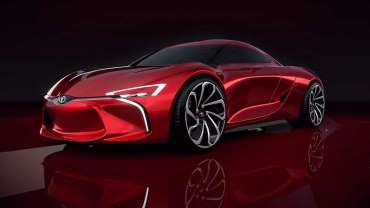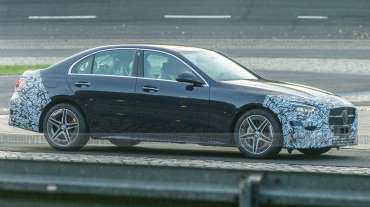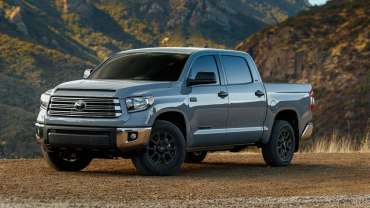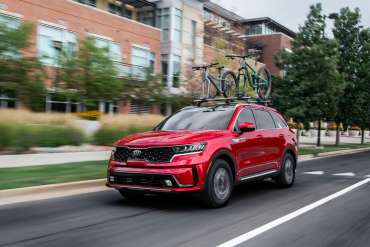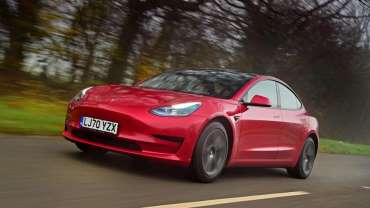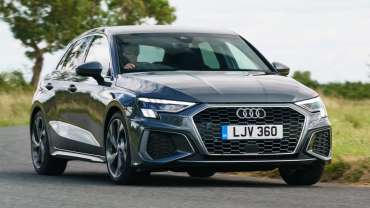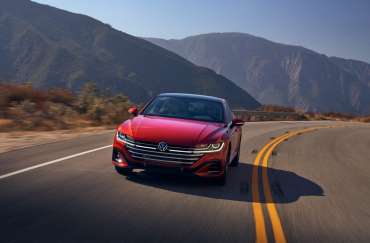
Worldcarblog.com
2024 Toyota MR2: What The Production Model Might Look Like
The MR2 might make a debut in 2024, let's have a look at all the possible technical enhancements and beautification which one could expect.
Toyota globally marketed the MR2 as a fun 2-seater sports car for a term that stretched over a span of 3 decades. They re-designs with each model aimed to overcome the flaws and append additional elements for styling and performance. Even today automotive enthusiasts hail this a majestic model for its best in class and rare mid-engine layout. How would you feel if you got to know that this ageless mini sports car could make an iconic come back soon? Also, have you pondered about how the fresh Mister Two (MR2) would look like?
With the rumor mill churning out reports that the MR2 might make a debut in 2024, let's have a look at all the possible technical enhancements and beautification which one could expect.
The Possibilities
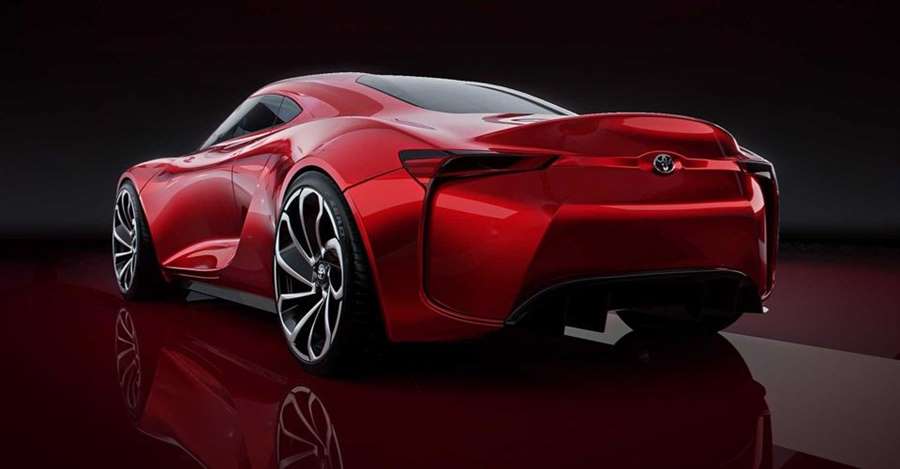
The pressing focal point for the designing wizards is to deliver an agile sports car with an emphasis on giving it a modern, sleek, and futuristic makeover. Clean and curved edges will not only enhance its flamboyant features but also be in tune with the operation of the law of aerodynamics. The first look of the revamped version of MR2 rendered digitally based on the archetypal model features a lightweight, dynamic, and easy to steer machine. Further, judging by the rumblings going on for quite a while now, we reckon that it will make a comeback with either an entirely electric or hybrid power train.
Besides that, one can expect a lot of improvements and sophistication in terms of elimination of the mishaps, as noted in the third generation W30 model. There are some wicked renders out there for all our favorite cars, and the MR2’s iconic status makes it one of those cars that have several renders available online.
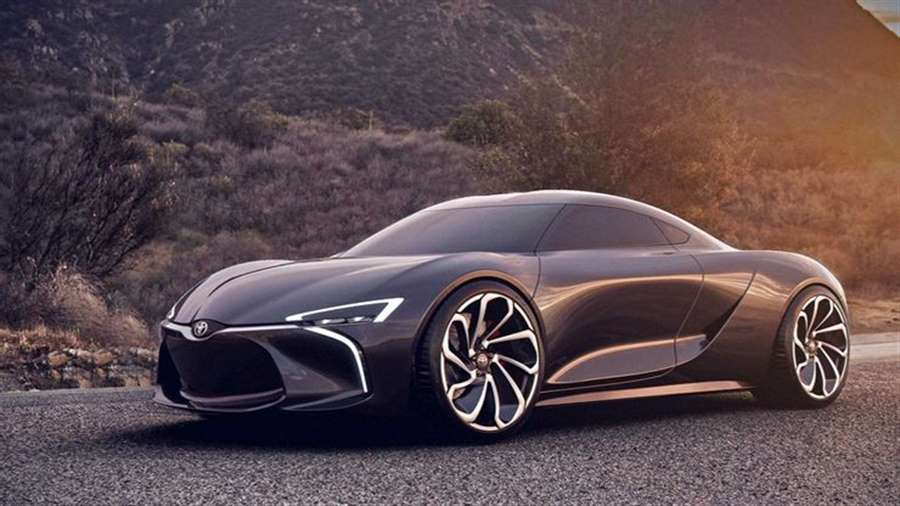
Even though the idea of reuniting the brands' '90s marquees, namely: the Celica, Supra, and MR2 have just made it to the discussion phase, there are talks in the town that Mr. Akio Toyoda would love to see the three sisters of the yesteryear make a comeback. Toyota has already launched GR Supra and the GT86 in the recent past which can be the replacement for the reconditioned versions of the erstwhile Supra and Celica, respectively.
The past releases hint towards future prospects that Toyota plans to do the same with MR2. Further, just as it collaborated with Subaru and BMW for the production of the 86 and Supra, there may be a probability that another such affiliation may already be in the pipelines.
Since the company is at the forefront to explore the electric car divisions, it may do so by introducing a full-fledged electric-powered prototype. An electric engine sounds fascinating for it would lead to an increase in peak performance measured in terms of horsepower. Drivers can expect an increase in the swiftness and acceleration of the car because of a lower center of gravity because of placing electric batteries under the floor.
All the models launched by Toyota to date, including the more recent ones like 86 and 2.0 Supra coupes, have been able to generate a maximum horsepower of 205 and 255 respectively. We expect the MR2 to glide this number up high to around 300+ HP. Moreover, in case Mr. Toyoda resolves to go for the same he may also have to possibly consider a long-term affiliation with Panasonic since at present it is the leading producer of EV batteries.
The most recent reports of the automobile industry suggest that the day is not far when Toyota will be power-packed to launch a fresh chapter of the MR2.
Source: hotcars.com
2022 Mercedes-Benz C-class
Overview
With a complete redesign in store for the 2022 Mercedes-Benz C-class, the entry-luxury car segment is in for a shakeup. The C-class has long served as the entry-point to the Mercedes-Benz lineup, but new additions to the brand in recent years such as the A-class sedan have allowed the C-class to move upmarket and better battle rivals such as the Audi A4, BMW 3-series, and Genesis G70. We expect the all-new 2022 model to continue to be built on a rear-drive platform, powered by a turbocharged four-cylinder engine and offer all-wheel drive as an option. The cabin is where we'll most likely see the most modernization, as the C-class is expected to borrow styling elements and technology from the newly-redesigned 2021 S-class sedan. Mercedes-Benz has been mum on details, and we've seen nothing more than some grainy spy photos, but the redesigned C-class appears to be on track for a debut sometime in 2021 as a 2022 model.
What's New for 2022?
In short: Everything. Spy photos of the redesigned C-class show a car that's clearly completely new and it's expected to launch for the 2022 model year.
Although we've only caught glimpses of camouflaged sedans so far, we expect Mercedes will continue to offer the C-class in coupe and convertible body styles as well. Without knowing more about the new car's standard and optional features, it's difficult to predict which one will be the best buy. When we learn more about the 2022 C-class, we'll update this story with details.
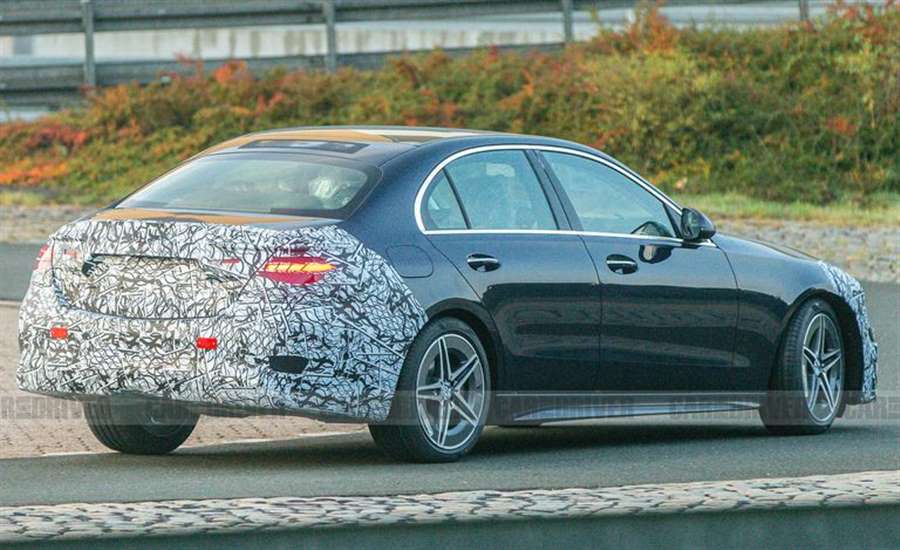
Engine, Transmission, and Performance
The 2022 C-class will likely continue to be powered by the same 255-hp turbocharged 2.0-liter four-cylinder engine as the outgoing model, but we expect it to start using the "350" designation in lieu of the current model's "300" to line up with the E350 sedan and GLE350 SUV, both of which use the same engine. All-wheel drive will likely remain an option with rear-wheel drive being the standard setup. When Mercedes releases information about the 2022 C-class's powertrain, we'll update this story with details.
Fuel Economy and Real-World MPG
The EPA hasn't posted fuel efficiency estimates for the 2022 C-class yet, but the new car's ratings shouldn't deviate much from the current model, which is rated at 23 mpg city and 33 mpg highway. When we get a chance, we'll put the new C-class through our 75-mph highway fuel economy test and report its results here.
Interior, Comfort, and Cargo
A full modernization of the C-class's cabin is expected and should include a digital gauge display, touch-sensitive controls, and a host of amenities. From the limited spy photos we've seen, we predict the car will have a steering wheel that looks similar to that of the redesigned S-class sedan's. The current C-class's interior is already one of the nicer cabins in the segment, with fine leather, real wood trim, and tasteful metallic accents, and we expect the 2022 model's cabin to be even nicer. Overall, the C-class looks to be similar in size to the outgoing model, so passenger and cargo space should be about the same.
Infotainment and Connectivity
If the redesigned S-class sedan is anything to go by—and we think it is—the C-class should launch with a large vertically-oriented center touchscreen similar to the 12.8-inch unit in the brand's new flagship. Regardless of screen size or orientation, the 2022 C-class will undoubtedly offer the most up-to-date version of Mercedes's MBUX infotainment system, complete with the voice-activated digital assistant, standard Apple CarPlay and Android Auto, and online access via a Wi-Fi hotspot.
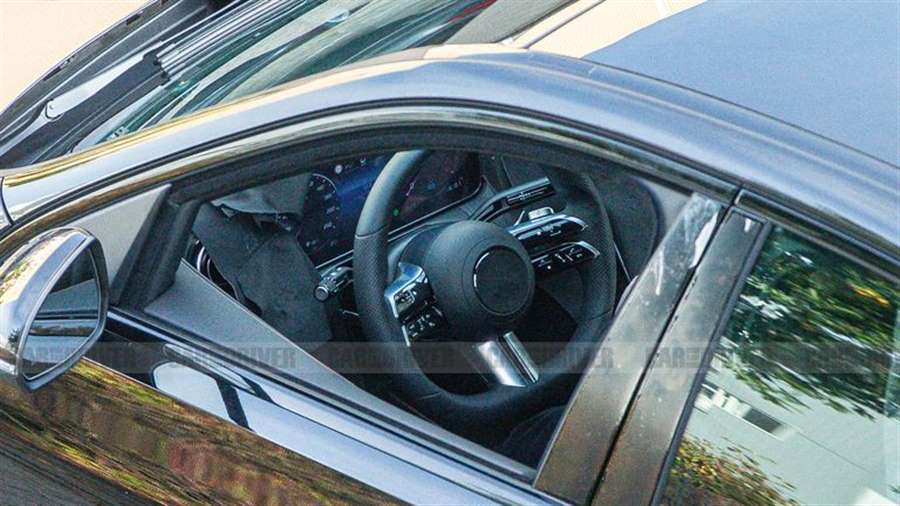
Safety and Driver-Assistance Features
Neither the National Highway Traffic Safety Administration (NHTSA) nor the Insurance Institute for Highway Safety (IIHS) have released crash test or safety information for the 2022 C-class. We are expecting Mercedes to pull out all the stops on driver-assistance features, though, and the new model should come standard with plenty of tech. Key safety features are likely to include:
Standard automated emergency braking with pedestrian detection
Standard lane-departure warning with lane-keeping assist
Available adaptive cruise control with semi-autonomous driving mode
Warranty and Maintenance Coverage
Although rivals such as BMW, Genesis, and Volvo offer three years of complimentary maintenance, Mercedes-Benz omits that benefit from its standard warranty offerings. Otherwise, all new Benz's come with an industry-standard plan that covers most things for up to four years or 50,000 miles.
Limited warranty covers four years or 50,000 miles
Powertrain warranty covers four years or 50,000 miles
No complimentary scheduled maintenance
Source: caranddriver.com
2022 Toyota Tundra: What We Know About the Next One
Will the next full-size Tundra pickup truly challenge the likes of the Ford F-150 and Ram 1500?
UPDATE: We've included exclusive MotorTrend renders based on leaks and various prototypes running around, showing aggressive front bumper and cutaways underneath the headlights. It should prove to be an interesting, bold evolution of the sort of styling Toyota has been exploring in its TRD Pro models, albeit much more extreme.
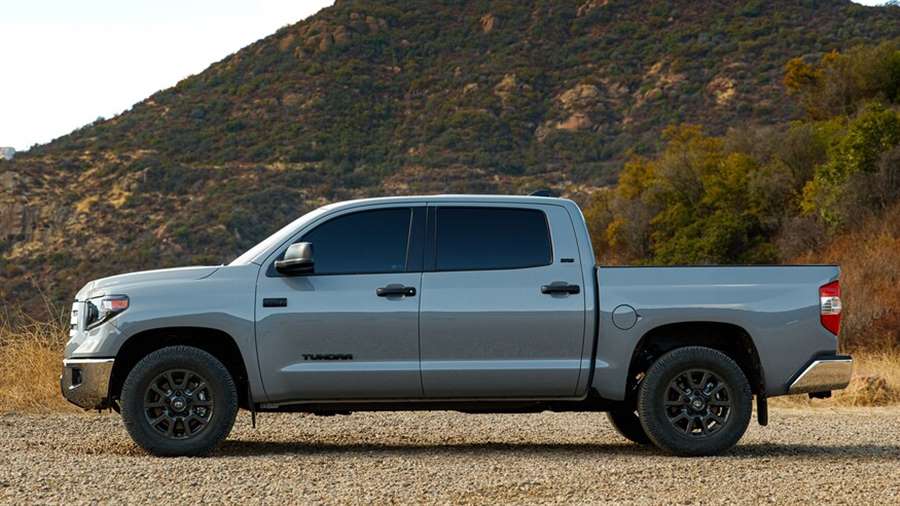
The current Toyota Tundra impressed us enough to earn the MotorTrend Truck of the Year award…in 2008. Since then, the Japanese automaker has merely put coats of lipstick on its aging pickup while rivals such as the Chevrolet Silverado, Ford F-150, GMC Sierra, and Ram 1500 received at least one full-on redesign. In other words, the Tundra's been left in the dust. However, Toyota finally is doing something about it.
The 2022 Toyota Tundra is due to ride on the company's latest truck chassis. Reportedly coined Toyota New Global Architecture-F (or TNGA-F), the Tundra's body-on-frame underpinnings ought to benefit from greater use of high-strength steel and other weight-saving materials. Like the Ram 1500, we anticipate the next-gen Tundra will adopt coil springs—in place of the current truck's leaf springs—to go with its live rear axle. Such a setup will surely improve the truck's ride quality. Likewise, we expect the lither 2022 Tundra to notably improve upon the outgoing model's maximum 1,730-pound payload and 10,200-pound towing figures. Of course, it will have to, with more-modern light-duty competitors offering capacities that far outstrip those dated numbers.
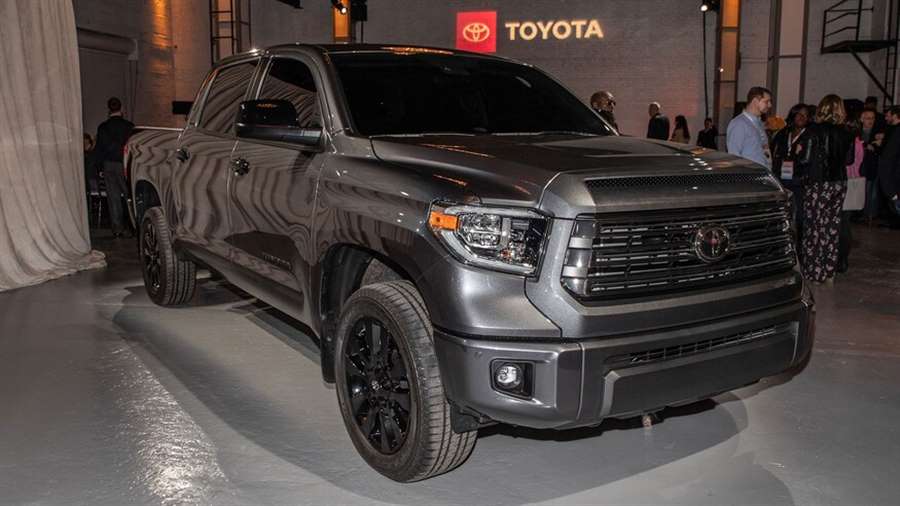
Say goodbye to the Tundra's V-8 engines, because Toyota's big pickup will reportedly enter the world with a V-6-only powertrain lineup. Look for higher-end Tundra variants to utilize a variant of the 416-hp 3.4-liter unit found under the hood of the Lexus LS500. Lesser Tundras will likely employ the naturally aspirated 278-hp 3.5-liter V-6 engine of the Tacoma (possibly massaged to produce more than 300 horses).
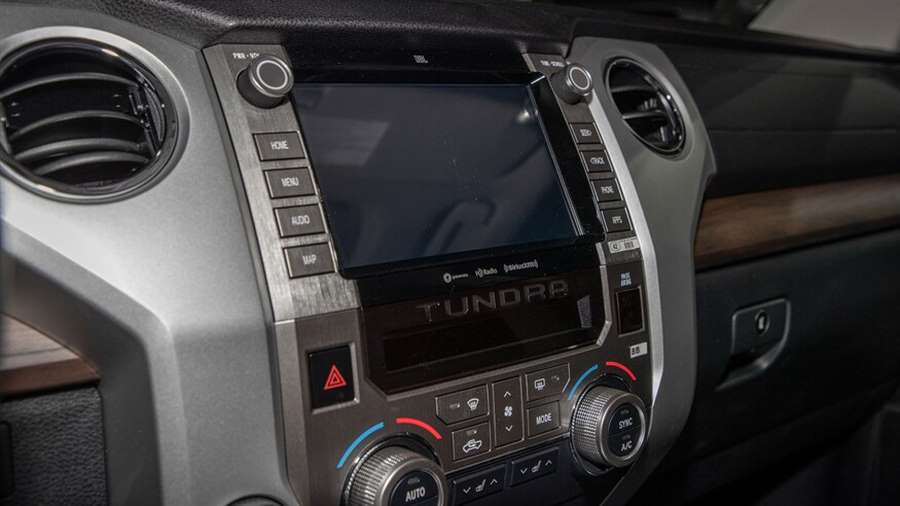
Given Toyota's hybrid history, the brand may offer the 2022 Tundra with a gasoline-electric hybrid powertrain option, putting it on the vanguard in a segment that is just now warming up to electrification. Such a setup will allow the Toyota truck to properly compete with the 2021 Ford F-150 and its available hybrid powertrain.
2022 Toyota Tundra's Truck-Like Looks
Despite its relatively radical mechanical changes, the 2022 Toyota Tundra is anticipated to evolve upon the styling of today's truck. That's no bad thing, as the current Tundra has finally grown into its skin—the original version looked like a four-wheeled fish of some sort—and comes across as innocuous enough, if not fully handsome. Still, look for the big Toyota truck to sport a brasher front-end design incorporating a large grille and tall hood, providing the new Tundra with a flashier mug.
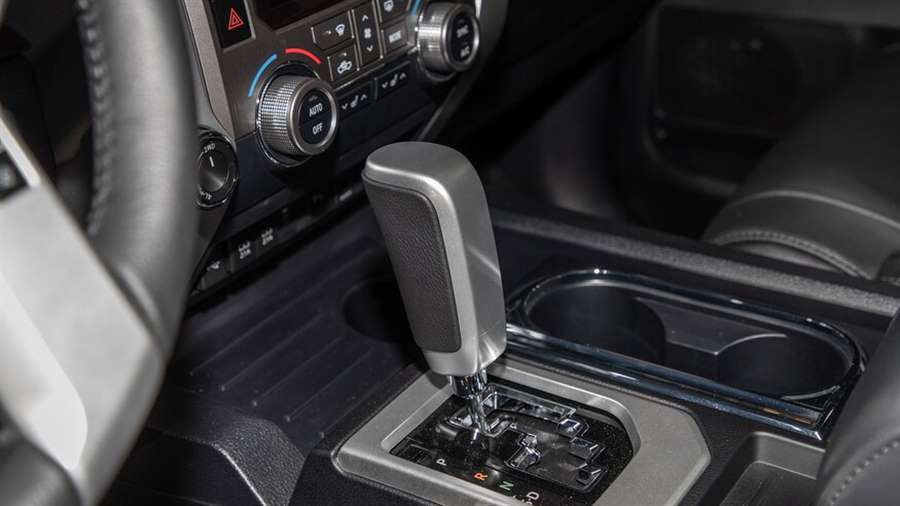
Inside, the new Tundra will welcome Toyota's latest Entune infotainment technology. This includes an available 12.0-inch touchscreen infotainment system and a large head-up display unit. Toyota's full Safety Sense suite of goodies are sure to be available, too, including automatic braking, advanced radar cruise control, automatic lane centering and lane-keep assist, and much more.
2022 Toyota Tundra On-Sale Date And Price
Although we expect Toyota to unveil the 2022 Tundra before the middle of next year, we don't anticipate the model rolling forth from Toyota's San Antonio, Texas, factory and reaching dealerships until the end of 2021. When it arrives, the 2022 Tundra may sport a base price close to that of the current truck's approximately $35,000 figure, or the brand might reintroduce lower, less-equipment-rich trim levels to the lineup in an attempt to capture fleet or entry-level buyers.
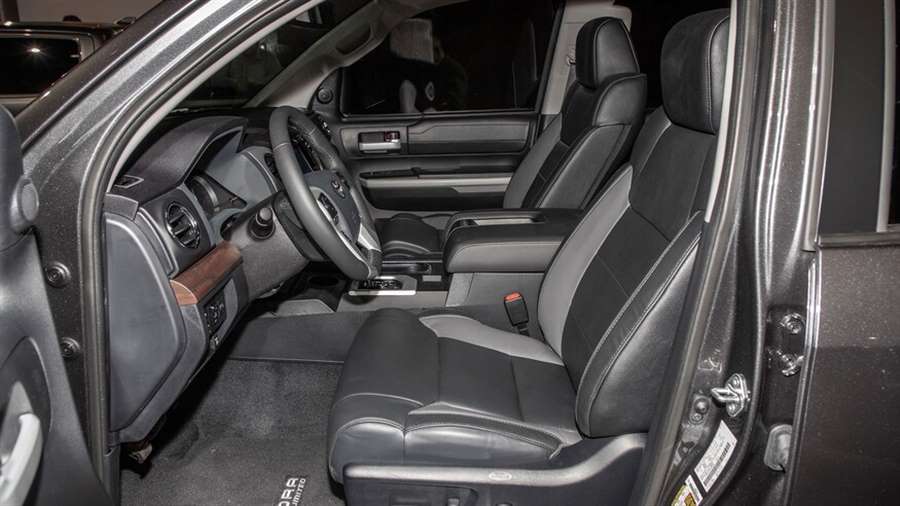
No matter what, opting for four-wheel drive, more technology, a larger cab or bed, and more powerful or advanced powertrain options will raise the truck's cost. Plan to spend north of $55,000 to get into the 2022 Tundra's pricier trims.
Source: motortrend.com
2021 Kia Sorento Is Compelling in Hybrid Form
The front-wheel-drive hybrid version of Kia's redesigned Sorento mid-size three-row crossover packs a solid 227 horsepower and a 37-mpg EPA combined estimate.
The new 2021 Kia Sorento hybrid doesn't make a big deal of itself, despite being the first electrically assisted version of Kia's mid-size crossover. It's got a 1.6-liter turbocharged four-cylinder mated to a six-speed automatic transmission, and it drives like you'd expect—except that the little four feels like it has about 25 percent more displacement than it actually does. In fact, the Sorento hybrid's combined output—227 horsepower and 258 pound-feet of torque—nearly matches that of the 2020 Volkswagen GTI. Like a GTI, the front-wheel-drive-only Sorento torments its front tires with torque. Unlike the compact GTI, though, it has three rows of seats and an EPA combined estimate of 37 mpg. Thus concludes our references to the Volkswagen GTI, but we hope the comparisons helped you subliminally internalize the idea that the Sorento hybrid is actually kind of fun.
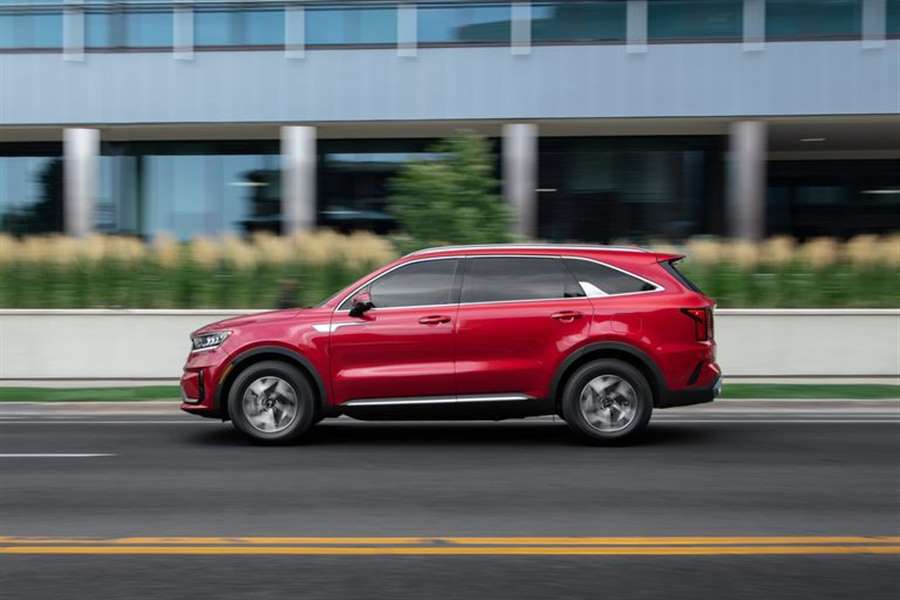
To get the Sorento hybrid's 227 horses out of a 1.6-liter turbo-four, you'd generally have to boost the bejesus out of it. Kia didn't do that. But it did pair the engine with a sizable electric motor and a 1.5-kWh lithium battery that enables some neat tricks. Such as producing an abundance of torque off the line and sailing along at highway speeds with the engine off. And yes, achieving solid fuel-economy ratings of 39 mpg in the city and 35 on the highway.
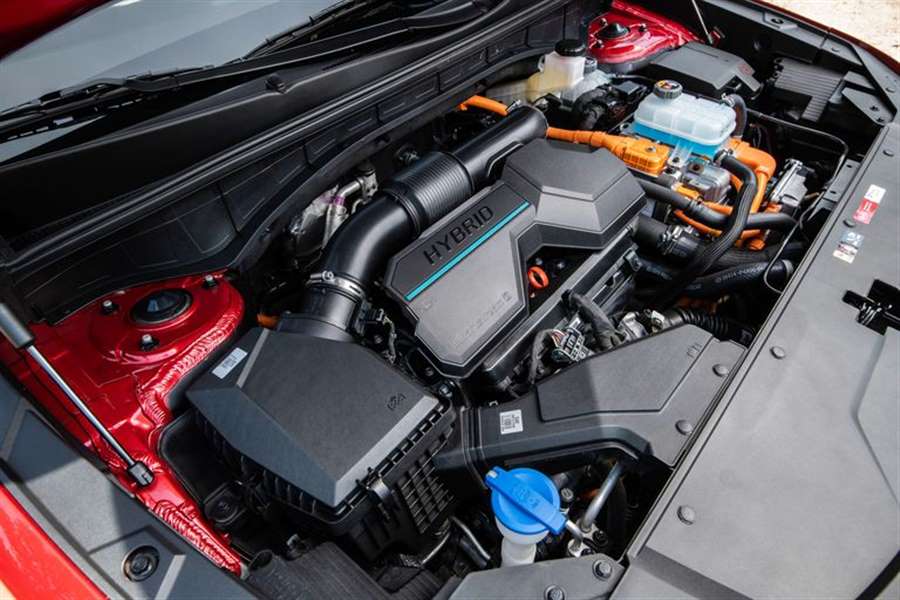
Kia's highly specific spec sheet lists the 1.6-liter as making 177.2 horsepower and 195.4 pound-feet of torque from 1500 to 4500 rpm. The electric motor generates a claimed 60.1 horses and 194.7 pound-feet from zero up to 1600 revs. Notice that those two torque figures are both almost the same and happen at low revs, which helps explain why the hybrid's low-end grunt feels diesel-like in strength. It's simply a smooth, prodigious shove that's out of proportion to the gas engine's displacement.
The 1.6 does sometimes lug at low rpm, particularly when climbing grades, as the transmission holds a tall gear and leans on the electric motor for help. But that's a common hybrid trait. As dealership sales reps like to say: They all do that. And, as we tend we say: At least it's not a CVT (continuously variable automatic transmission). Should you desire a lower gear from the Sorento hybrid's conventional automatic, there are paddle shifters on the back of the steering wheel.
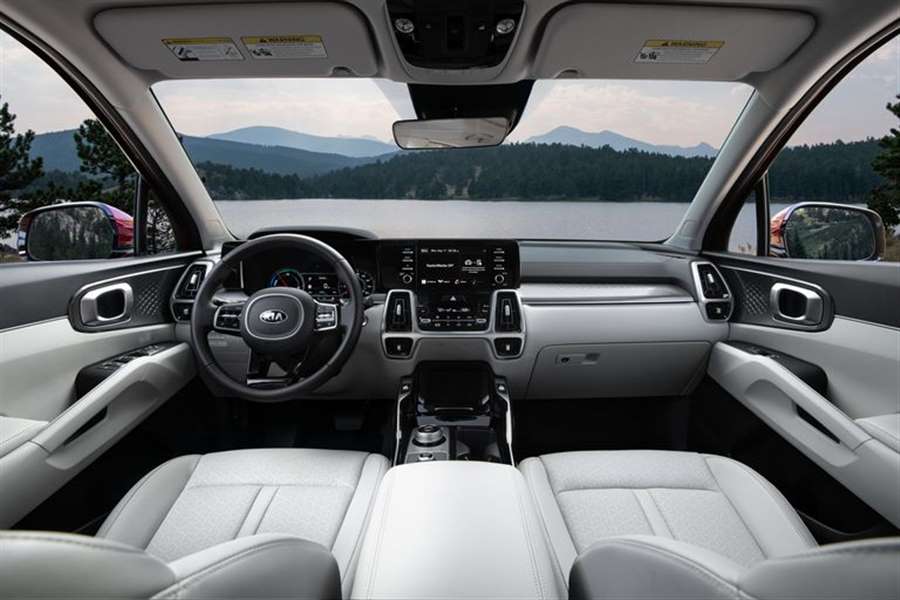
The Sorento hybrid offers no dedicated electric-only mode, but nonetheless it relies on electric power surprisingly often and at high speeds. Light on the throttle, downhill, you'll see the green EV indicator light come on at 80 mph. While its relatively tiny battery means you won't ever go far on electricity alone, this Sorento is good at seamlessly juggling its propulsion options without calling attention to the machinations happening beyond the firewall.
Priced at $34,760 to start for the base S trim, the hybrid costs $1700 more than a non-hybrid Sorento S, which employs a 191-hp naturally aspirated 2.5-liter four-cylinder and an eight-speed automatic. That model is only rated for 26 mpg combined, and the EPA figures that over five years, the hybrid will save you $1750 in fuel. Your mileage may vary, of course, but you'll notice that those estimated savings neatly erase the hybrid's price premium. It looks as if a half-decade is your financial break-even point, if that's a motivating factor. But the hybrid also is the significantly more powerful option, and that's a worthy upgrade on its own. Just don't expect it to outpace the nonhybrid Sorento's optional 281-hp 2.5-liter turbo-four that we've already driven.
In terms of drawbacks, the Sorento hybrid has a couple. It's only available as a front-driver, so if all-wheel drive is nonnegotiable you'll need to look elsewhere—or wait for the upcoming plug-in hybrid variant that drives all four of its wheels with a combined 261 horses and a significantly larger battery. The hybrid also shouldn't be your pick if you expect to tow much with it, as its 2000-pound tow rating lags behind the nonhybrid models' 3500-pound max. But if neither of those factors is an issue, you may as well spring for the hybrid over the standard Sorento. Think of it as a five-year investment in free horsepower.
SOurce: caranddriver.com
New Tesla Model 3 Standard Range Plus 2020 review
The updated Standard Range Plus version of Tesla's Model 3 is the most accessible in the line-up but still shows that star quality
Verdict
None of the changes to the latest Model 3 transform the car in any way, but nonetheless they’re all welcome. It still remains Tesla’s best car and a brilliant package overall, and this entry level point in the range should be considered as a hugely tempting alternative to traditional compact execs like the BMW 3 Series - especially for company car drivers.
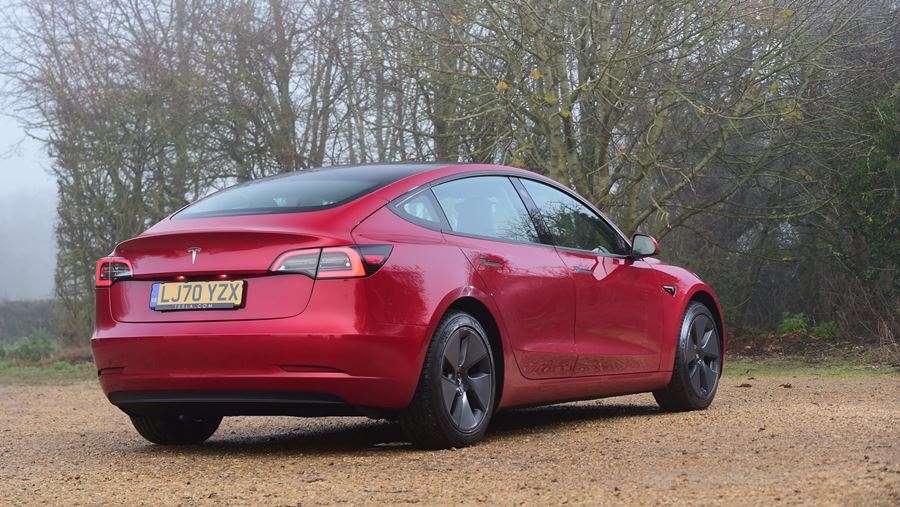
This is the Tesla Model 3 Standard Range Plus. Newly revised for 2021, it’s the entry point to both the Model 3 lineup and the Tesla family as a whole in the UK, with prices starting from £40,490 - tantalisingly close to the BMW 330e plug-in hybrid. So is it worth ditching the traditional compact exec of choice to go fully electric?
There’s quite a few changes introduced in this round of updates, but from the outside they’re rather tricky to spot. A new black pack replaces some of the chromed exterior details like the door handles, door mirror stalks and window trims, and the wheel choices are refreshed with more aero-efficient 18- and 19-inch designs, plus new optional 20 inch items. Otherwise, those vanilla looks mean that the styling isn’t the reason to go for a Model 3.
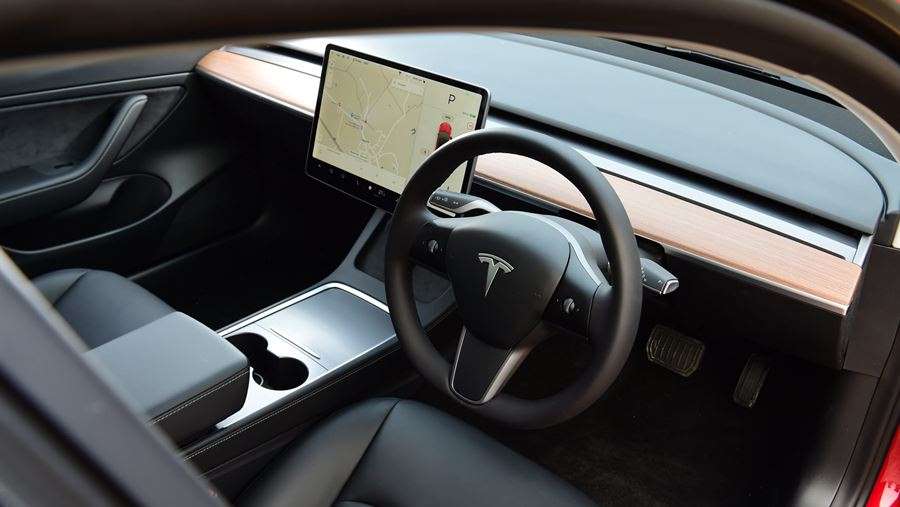
The interior just might be however. Whether you think it’s a triumph of minimalism or just a bit too plain compared to alternatives, it’s hard to argue that the cabin is unique. It’s got better in the most recent round of changes, too, particularly around the centre console.
Previously, the Model 3 had an odd and needlessly overcomplicated flip lid beneath which it was possible to store a smartphone. This has been replaced with a simple pad, which has a couple of grooves which not only keep two devices in place, but can charge them wirelessly.
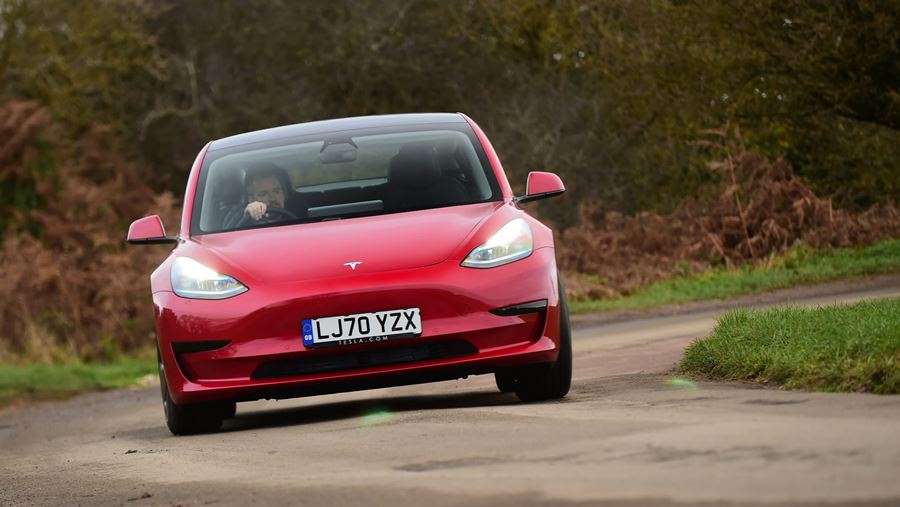
Further along, a huge deep cubby space remains, but now it’s accessed through a much more straightforward sliding lid. The easily scratched piano black surface is gone, too - a more subtle and more durable grey finish takes its place.
The steering wheel looks similar to before, but the two scroll wheels have been tweaked for a more expensive feel. Depending on which menu is selected on the huge 15-inch central touchscreen, each of the wheels adjusts one of a multitude of functions: the door mirror adjustment, the steering column position and the media functions among them. Assuming you do all of the prep before you set off, they work really well, though condensing so many functions down into two controls is not particularly intuitive on the move.
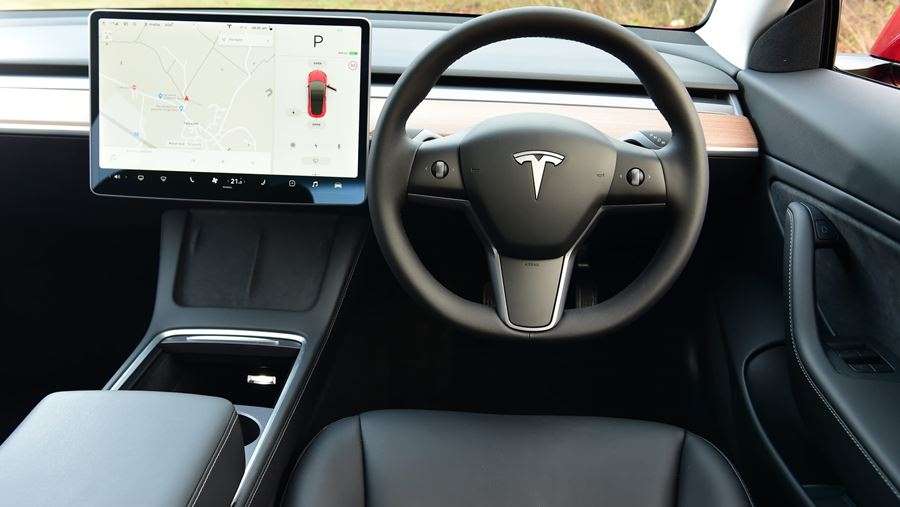
That huge display is brilliant, though. Whether judged on its graphics, processing power or user interface, it’s among the best infotainment systems available in any car. Of course, there’s no traditional instrument panel either, so it also displays all of the vital driving functions like speed and remaining battery charge.
The boot lid is now electrically operated. While the volume is on a par with manu rivals, the opening is small - though the Model 3 looks like a hatchback, it isn’t. The front boot, meanwhile, has shrunken slightly. This is because some of the space has now been occupied by a new feature to the Model 3: a heat pump.
First used by Tesla on its Model Y, a heat pump takes the place of the previous resistive heater. Put simply, the new system works a little like a fridge, compressing a fluid which generates heat. This heat can then be used to warm the cabin or, by reducing the fluid’s pressure further along the system, produce a colder flow of air instead. The main plus point of a heat pump is that it’s more efficient than the resistive heater to warm the cabin, which reduces the range impact when trying to keep toasty in colder climates.
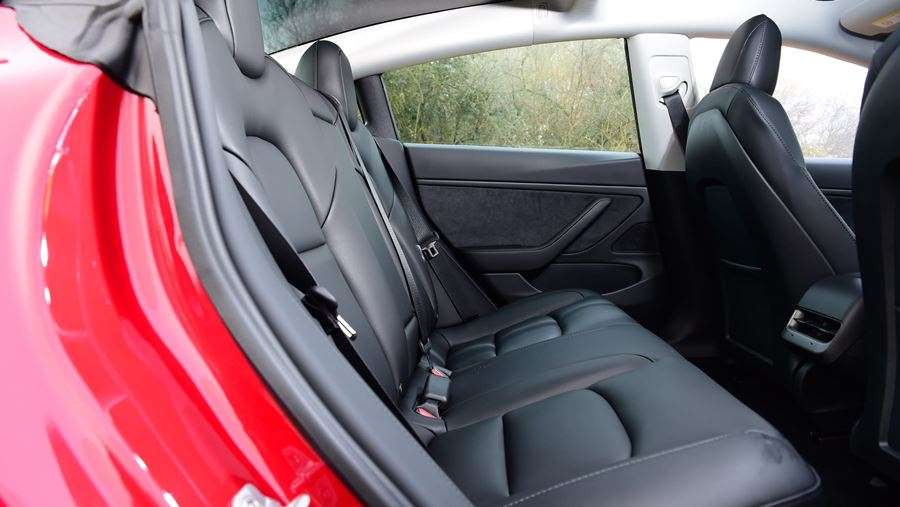
Along with some subtle software tweaks, the new heating system means that range has improved slightly across all of the Model 3 variants. In the case of this entry level SR +, the resulting 267 mile figure is 13 more than before. In our experience the real-world figures came close, if not completely matching that number, even on a day when temperatures barely made it above freezing.
Unlike the top end Performance versions, the Standard Range Plus makes do with just one electric motor driving the rear wheels. While the drop in acceleration is noticeable compared to the twin motor setup, the Model 3 is still, put simply, a fast executive saloon.
A 0-62mph time of 5.2 seconds really doesn’t do the Model 3 justice. At any speed, the lightning fast throttle response and instantaneous torque gives proper hyper hatch eagerness. It easily has the legs over the BMW 330e.
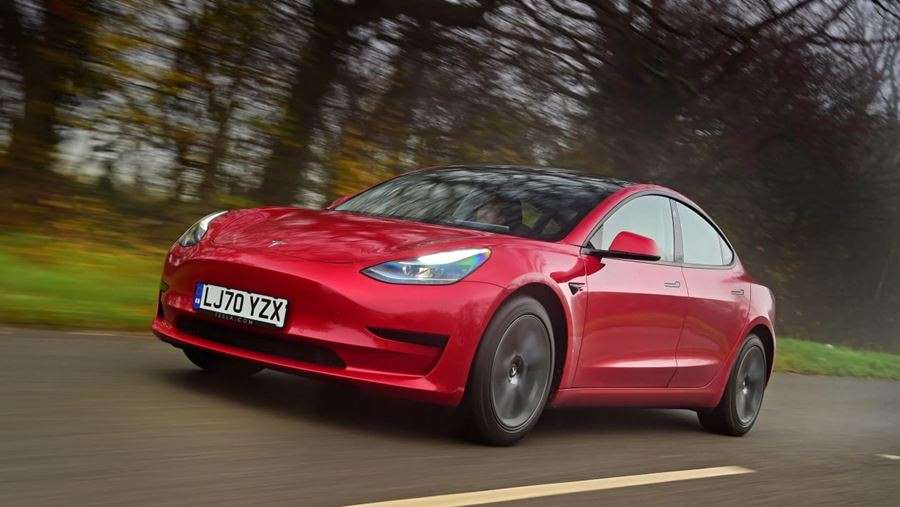
It’s also wonderfully easy to drive at low speeds. The Model 3 has possibly the smoothest integration of a one pedal driving system of any EV on sale: while some rivals decelerate quite harshly and then creep at low speeds, with the correct mode selected, the Tesla will trim of speed gently and come to type of gentle halt that would make a chauffeur proud.
When it comes to fun, it’s closer to the BMW than you might think, too. It’s certainly not as sophisticated, for the most part due to damping that feels a little loose compared to the 3 Series. However, this translates into a chassis that can be quite playful if provoked and, thanks to a kerb weight that dips 219kg below that of twin motor Model 3s, it’s fairly agile, too. That weight is low down, so stability is a strong point in everyday driving.
The steering is a weak point though. Even in its lightest “comfort” setting, the heavy feel and gloopy feedback isn’t pleasant, and it only gets worse in the sportier settings. The chunky steering wheel rim doesn’t help its case either - robbing what little information that could be transferred from the front wheels.
The lack of any combustion engine highlights another area where the Model 3 needs work. On the move, there’s plenty of road noise transferred into the cabin, and despite the addition of acoustic glass in the latest round of updates, it’s one of few aspects of the Model 3 where Tesla still has room for improvement.
For company car users, the Model 3 will prove to be a bit of a bargain. In the current tax year, Model 3 drivers will not have to pay any Benefit in Kind rates at all, and though costs will increase slightly over the next couple of years, the zero-emission Tesla will still only demand annual costs of a few hundred pounds. Even the BMW 330e, whose plug-in hybrid powertrain makes it significantly cheaper than conventional petrol and diesel options, will cost upwards of £1,600 each year for a 40 percent earner.
Then there’s the greatest Tesla benefit of all: the Supercharger network. An abundance of chargers are available all over the country, and it’s so incredibly simple: turn up, plug in and drive away once you have the range you need. Users are billed by the kilowatt-hour, with a 26 pence per unit figure very competitive with other charge companies suppliers. It means a full charge of the SR+’s battery costs £14.04. That’s not only cheap by the standards of other charge suppliers, but much cheaper than similarly sized combustion-engined cars.
| Model: | Tesla Model 3 Standard Range Plus |
| Price: | £40,490 |
| Drivetrain: | Single electric motor |
| Power/torque: | 292bhp/376Nm |
| Transmission: | Single speed, rear-wheel drive |
| 0-62mph: | 5.3 seconds |
| Top speed: | 140 mph |
| Range: | 267 miles |
| On sale: | Now |
Source: autoexpress.co.uk
Audi A3 Sportback hatchback review
"The striking Audi A3 Sportback now has the technology it needs to compete with rivals"
Since its arrival in 1997, the Audi A3 has set the template for affordable upmarket cars, selling to more than 600,000 customers in the UK alone. It goes up against a host of strong rivals, most notably the BMW 1 Series and Mercedes A-Class, while the Volkswagen Golf is a slightly more affordable alternative.
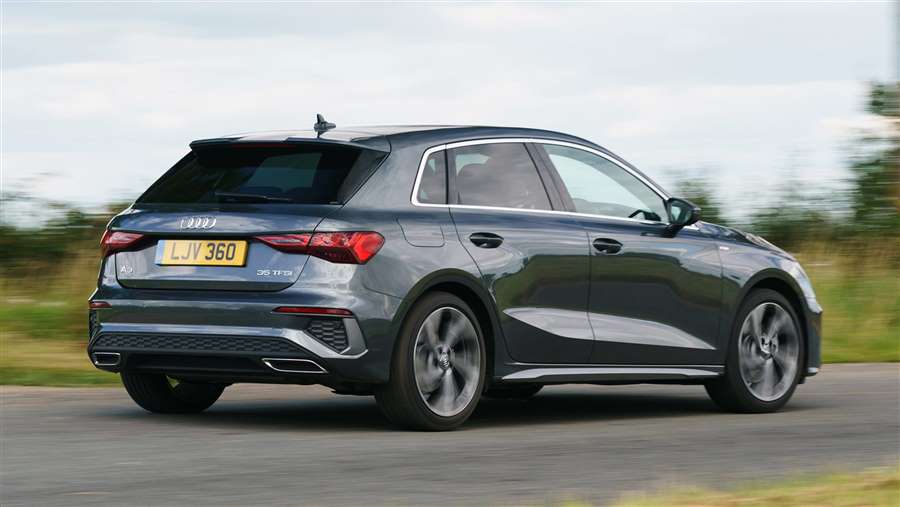
For its fourth outing, the notoriously conservative A3 has a bolder, more exciting exterior design that changes quite markedly depending on which trim level you choose. The entry-level Technik is relatively sedate, while the S line trim adds a sporty body kit and sharp LED exterior and interior lighting. There isn’t a three-door model anymore, so the five-door Sportback is offered initially and will be joined by a four-door saloon. It's also likely we'll see a coupe-like version of the A3 to rival the Mercedes CLA, and possibly even a crossover model in due course. There's a powerful S3 model in the works and an even faster Audi RS3 is due in 2021.
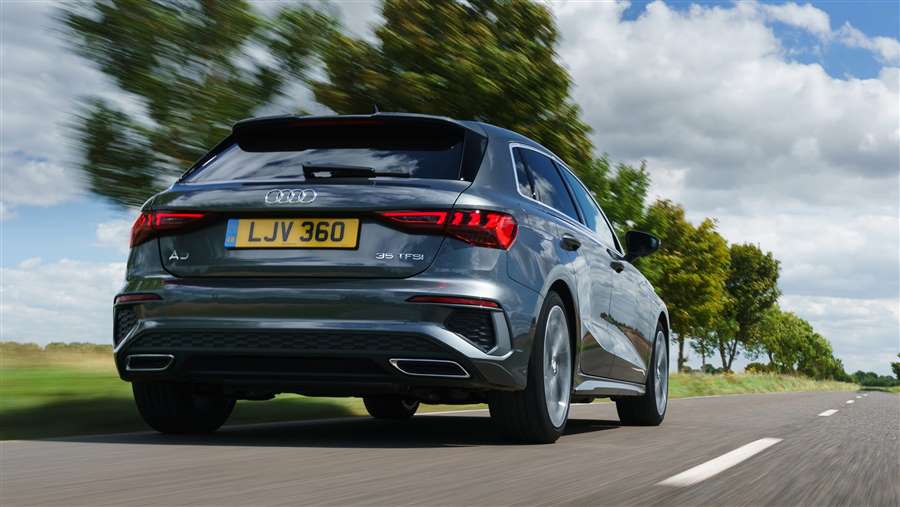
Best luxury small cars
The interior is similarly radical, with analogue dials replaced by a standard Virtual Cockpit instrument display and every A3 coming with a 10.1-inch infotainment screen. Rather than sitting atop the dash, this is now integrated into the centre console, and the driver has a more cocoon like seating position than before. Quality is excellent, even in versions using upholstery manufactured from recycled plastic bottles, and technology feels two generations ahead of the outgoing model.
A small increase in width and length means passengers should find there's a little more room to stretch out, but boot space is exactly the same at 380 litres, matching most competitors.
Engines are familiar but updated, and buyers can choose between regular petrol and diesel combustion engines with mild-hybrid technology for slightly lower running costs, or a plug-in hybrid ‘40 TFSI e’ model. We expect the 1.5-litre petrol with 148bhp in the A3 35 TFSI to be a strong seller, offering 0-62mph in under nine seconds and fuel economy of over 45mpg. We even managed to better this figure over several hundred miles of driving. High-mileage drivers should also consider the A3 35 TDI, which has lower tailpipe emissions than older versions and manages up to 61.4mpg, while also feeling punchier than the petrol.
Handling is assured and secure, even in the front-wheel-drive versions we've tried so far. Quattro four-wheel drive will also be available, but our prediction is that it will be unnecessary for most drivers until much more powerful versions arrive.
Audi A3 Sportback hatchback - MPG, running costs & CO2
Efficient petrol and diesel engines, mild hybrid tech and a plug-in hybrid offer plenty of choice
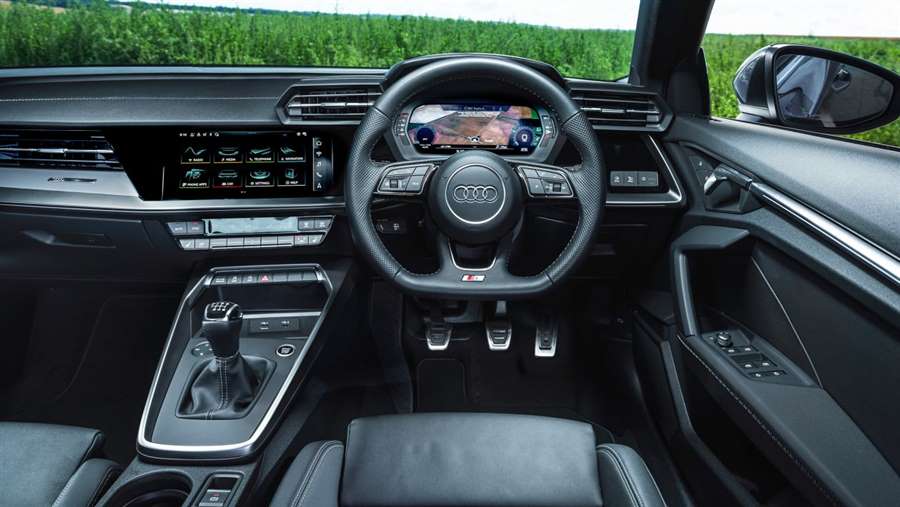
Audi is broadening the choices offered to A3 owners, so while petrol and diesel engines are available, these options are bolstered by mild-hybrid technology and the arrival of a fully fledged plug-in hybrid A3 40 TFSI e. The latter uses a petrol engine, electric motor and battery to provide an electric range of around 41 miles, slashing fuel use and CO2 emissions.
Audi A3 MPG & CO2
Sticking with petrol first, the 148bhp 1.5-litre '35 TFSI' petrol engine has the option of mild-hybrid technology, incrementally increasing fuel-efficiency and cutting CO2 emissions. This will arrive shortly after launch, but until then the standard engine is hardly a gas guzzler, managing up to 48.7mpg with a manual gearbox. With emissions from 132g/km, it's also affordable for company-car drivers thanks to a reasonable BiK band.
During hundreds of miles of mixed driving, we found the 1.5-litre petrol even more economical than advertised, managing exactly 50mpg. This is impressive for a petrol family car, and helps make the A3 a great all-rounder.
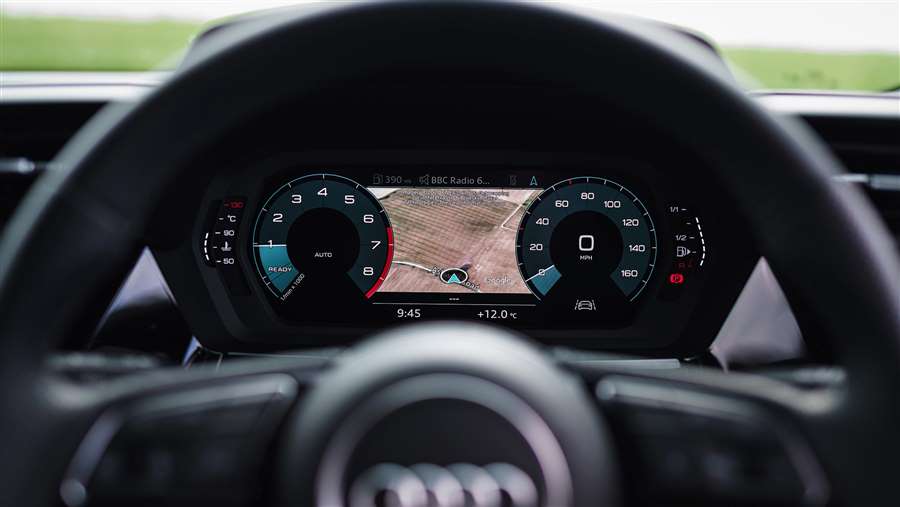
The smaller 1.0-litre petrol engine is badged as ‘30 TFSI’ and is capable of up to 51.4mpg when the car has 16-inch alloy wheels fitted. Its emissions figure of 124g/km places it in a relatively high BiK band.
Topping the economy charts is the 40 TFSI e plug-in hybrid, which is officially capable of around 41 miles of pure-electric running and economy of up to 282.5mpg. Emissions of 25-30g/km give the A3 PHEV a low BiK banding, meaning it’s the model that will appeal most to company-car drivers. The 13kWh battery can be charged in around four hours using a home wallbox.
Choose the 35 TDI diesel, perhaps if you have a high annual mileage, and you can expect up to 61.4mpg. BiK payments will be higher, with CO2 emissions from 120g/km, depending on which trim level and alloy wheels are selected. A 30 TDI with 114bhp is also available with even better efficiency figures, returning up to 64.2mpg with emissions starting from 115g/km.
Insurance groups
Choose a 1.0-litre Audi A3 30 TFSI Technik and insurance groups start from 17, while a more powerful A3 35 TFSI Edition 1 is in group 26 out of 50. That's the same rating as the diesel A 35 TDI in S Line trim.
Warranty
Audi provides a three-year/60,000-mile warranty, which is fairly average for the class and can be extended for an extra cost. Increasing it to four years and 75,000 miles costs £300, while a five-year/90,000-mile warranty is just over £600 extra, despite a five-year/100,000-mile warranty coming as standard with a Hyundai i30 or Toyota Corolla.
Servicing
Audi typically offers customers two servicing plans: one for low-mileage drivers who are likely to take more short trips, and another for motorists who have a higher mileage and tend to take longer motorway trips. The first sees maintenance take place annually, while the latter uses sensors to measure wear and suggest a service - although these will never be more than two years apart.
Audi A3 Sportback hatchback - Engines, drive & performance
Regular versions of the A3 are smooth and controlled but not especially engaging
The Audi A3 has always been a smooth, assured car to drive, without necessarily offering the enjoyment of rivals like the BMW 1 Series. Based on an upgrade of the existing MQB platform, there's little about the latest A3 that tears up the rulebook here, and the A3 has similarly mature and slick manners as before.
Even the front-wheel-drive versions have plenty of grip, with an unflappable feel aided by multi-link rear suspension - a more expensive design than the torsion beam setup found in some cheaper cars, fitted in versions with 148bhp or more. Optional Progressive Steering needs smaller inputs at lower speeds and can be altered in different driving modes. It's a bit light and lacking in feel but switching into 'Dynamic' mode adds some weight. Buyers can also choose adaptive suspension, which works better than before, providing decent ride comfort. The standard suspension setup is also improved, so while adaptive suspension is a tempting feature, it isn't essential.
Audi A3 petrol engines
The entry-level petrol is a 1.0-litre three-cylinder turbo badged 30 TFSI with 109bhp. Despite its low output, it's eager to rev and gets the A3 from 0-62mph in 10.6 seconds. A surprising top speed of 127mph also means it shouldn't feel strained at the national speed limit. Just a six-speed manual gearbox is available, so the 30 TFSI is off the table if you want an automatic.
With 148bhp, the 1.5-litre engine in the A3 35 TFSI can get from 0-62mph in 8.4 seconds with a seven-speed S tronic automatic gearbox. That should be plenty fast enough for most families, and its 139mph top speed will make motorway cruising at 70mph nicely relaxed too.
It doesn't feel quite as nippy as you may expect but there's enough performance available to make it an acceptable all-rounder and our pick of the range. The six-speed manual gearbox has a light throw but can feel a bit jerky at low speeds. Luckily a high proportion of buyers are expected to opt for the automatic.
Hybrid engines
The 40 TFSI e plug-in hybrid combines a 1.4-litre petrol engine, a 13kWh battery and an electric motor to produce 201bhp. Power is sent to the front wheels via a six-speed automatic gearbox. Performance is brisk, with the plug-in A3 managing 0-62mph in 7.6 seconds and a top speed of 141mph.
Diesel engines
At launch there was just one 2.0-litre four-cylinder diesel engine badged 35 TDI, which is quieter than in the previous A3. It comes with front-wheel drive and the same automatic gearbox as the petrol at first, with four-wheel drive quattro also on the way for added traction. Power is identical at 148bhp, but extra torque makes the diesel feel punchier than the 35 TFSI in traffic and for overtaking.
This has now been joined by a 30 TDI version, which uses a 114bhp version of the same engine. Designed primarily with economy in mind, it still gets from 0-62mph in a reasonable 10.1 seconds. Like the entry-level petrol, it's also available with just one six-speed manual gearbox.
Audi A3 Sportback hatchback - Interior & comfort
The fourth-generation Audi A3 is more like a computer on wheels than before
Along with its premium badge, the A3's main selling point has always been its upmarket interior. In fact, along with the BMW 1 Series, the A3 was one of the first cars to offer an executive class ownership experience in a smaller package; a trick countless hatchbacks and crossovers now try to pull off.
For its fourth outing, Audi has focused on technology, with a big step-up in processing power for its infotainment system to keep occupants connected, provide real-time navigation updates and media, while also improving safety.
Audi A3 dashboard
There's a different feel to the driver's seat in the latest A3 because an angled dashboard, wide centre console and even the air vents on either side of the instruments, all lend it a focused, cockpit-like atmosphere. Soft-touch materials have been replaced with swathes of aluminium-style trim.
It goes without saying that it's far more modern than its dated predecessor, but retains that car's narrow, wing-like dashboard structure and minimal approach. The infotainment screen no longer sprouts from the dashboard, instead sitting adjacent to your hand on the steering wheel, while Audi's Virtual Cockpit digital instruments are also standard. Unlike the latest Volkswagen Golf with its touch-sensitive slider, many will be glad its climate controls are still physical buttons.
An automatic gearbox with a small toggle-like gear selector means designers have been able to get more creative with their design, making space for a wireless charging smartphone pad below the centre console. There's also a small iPod-style controller for the stereo system but its functions are limited to changing the volume and skipping media tracks.
Equipment
No less than five trim levels will be offered, called Technik, Sport, S line, Edition 1 and Vorsprung, with Technik and S line likely to be most popular. Technik is similar to the SE trim Audi has used previously, with 16-inch alloy wheels and cloth seats, but standard features like a 10.1-inch touchscreen with sat nav, a 10.25-inch Virtual Cockpit and LED headlights mean it's still well equipped.
Sport brings an aesthetic upgrade with larger wheels and a part-leather interior, along with a choice of driving modes, dual-zone climate control and folding door mirrors. S line alters the A3's looks again with 18-inch wheels, LED rear lights with sweeping indicators, privacy glass, sports seats and ambient interior lighting. It's a desirable makeover, that seems to strike a chord with UK buyers.
Edition 1 and Vorsprung both aim to give the A3 an even more premium feel, adding technology such as Matrix LED headlights, a Bang & Olufsen stereo, Virtual Cockpit Plus and even larger wheels.
Options
Audi has long been prolific when it comes to options, even making it possible to personalise and upgrade its smallest A1 city car to feature almost every feature under the sun. That continues here, but some options like the Comfort and Sound Pack for Technik cars look sensible, adding parking sensors, heated front seats, a rear-view camera and Bang & Olufsen sound system for £1,200. It's also a good idea to include a space-saver spare wheel for £120, although charging £25 for a tool kit and jack is stingy.
Audi A3 Sportback hatchback - Practicality & boot space
A slight size increase brings small gains inside, while the boot is on par with rivals
Shifting trends mean Audi no longer sells a three-door A3, so the five-door Sportback is now the standard car, with a four-door saloon version set to follow later.
Audi A3 interior space & storage
The latest model is slightly longer and wider overall, and the benefit of this is slightly more headroom and legroom front and rear. There's plenty of room with four passengers but the middle seat isn't as comfortable, so is best reserved for short trips only.
Boot space
While passenger space is boosted slightly, boot space remains unchanged at 380 litres behind the rear seats, expanding to 1,200 litres when they're folded down. Technik trim level comes with 60:40 split and fold rear seats, but these are upgraded to a 40:20:40 design for Sport. This gives the benefit of a load-through for long items such as skis or snowboards, as well as a centre armrest with cup holders.
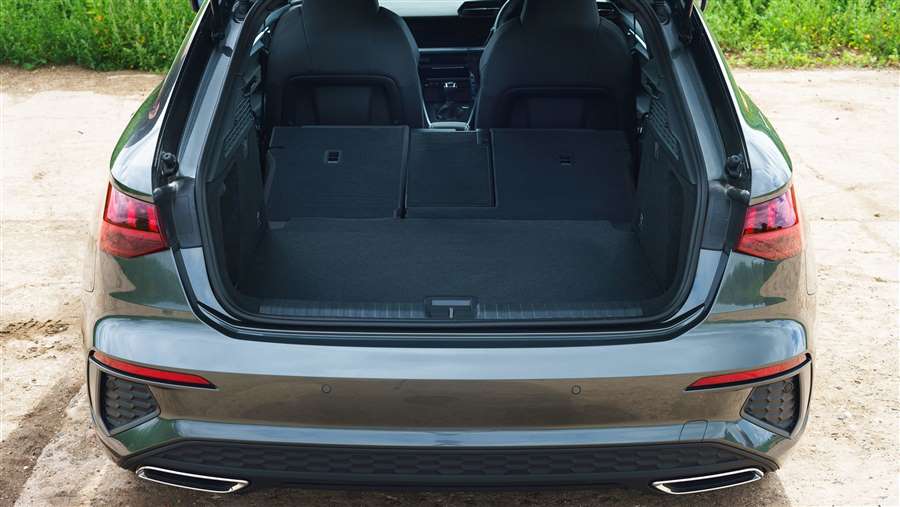
In the plug-in hybrid 40 TFSI e model, overall boot space is reduced to 280 litres due to the car’s battery; the boot floor is raised to accommodate it.
The A3 remains competitive in the class, with identical luggage space to the BMW 1 Series and Volkswagen Golf, while the 370-litre boot in the Mercedes A-Class is slightly smaller. The A3 also boasts a usefully wide boot opening and there’s no luggage lip to haul bags over.
Towing
A removable towbar with a 13-pin socket, that can swivel up behind the bumper when not in use, is available as an official accessory for around £800. The A3 Sportback can make a surprisingly good tow car, with even the 30 TFSI petrol rated to tow a 1,500kg braked trailer, climbing to 1,800kg for the diesel engines.
Source: carbuyer.co.uk
Tested: 2021 Volkswagen Arteon Doubles Down on Design
Interior and exterior updates make VW's flagship Arteon hatchback look even more like an upscale Audi but do little to invigorate its road manners.
The 2021 Arteon is by far the most beautiful machine in Volkswagen's portfolio. Its long, low, and wide proportions convey the type of elegance typically reserved for models wearing Audi's famous interlocking rings rather than VW's humbler logo. It's far more like the sultry A5 Sportback than the generic Passat.
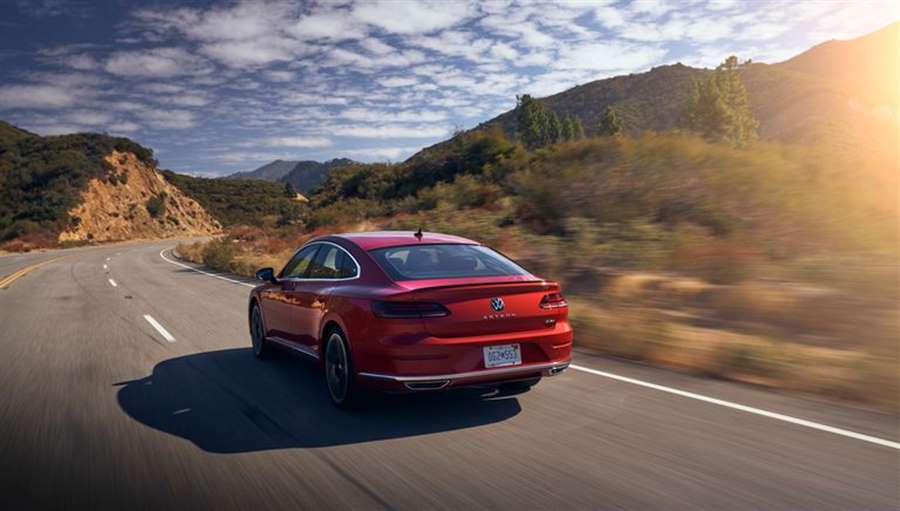
Despite its avant-garde aesthetic and luxury-grade amenities, Volkswagen's sleekest hatchback (cleverly disguised as a fast-roofline sedan) isn't a big seller in the United States. Since arriving as a 2019 model, just more than 5000 copies found buyers through the third quarter of 2020. But the Arteon wasn't built for mass appeal. VW has an expanding roster of crossovers to satisfy the masses and protect its profit margins. Instead, the Arteon was made even prettier and more desirable for the 2021 model year, to continue to entice individualists who appreciate its Audi-adjacent style.
Under the Influence of Audi
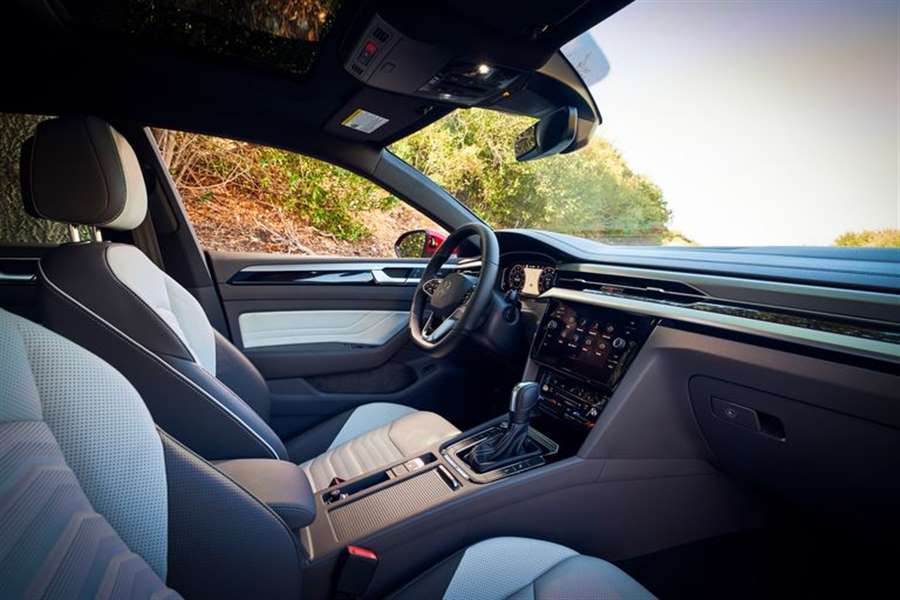
We tested a top-of-the-line Arteon SEL Premium R-Line painted in Pyrite Silver that rode on a set of newly designed 20-inch wheels. The cabin gets a more dramatic update than the exterior, with VW adding some tasteful visual flair. The upper part of the dashboard now has a modernized design that scraps the pointless analog clock and relocates the buttons above the infotainment system to the bezel around the shifter. The cabin also looks great at night, the new ambient lighting featuring 30 selectable colors that highlight a strip across the dash, translucent panels on the doors, and even elements in the fully digital gauge cluster and 8.0-inch touchscreen. We're also fond of the new steering wheel's contoured grip and girthier rim, but our winter gloves unintentionally activated its new haptic controls more than once. Other Audi-influenced additions include standard touch-sensitive climate controls that were less distracting and more responsive than we expected.
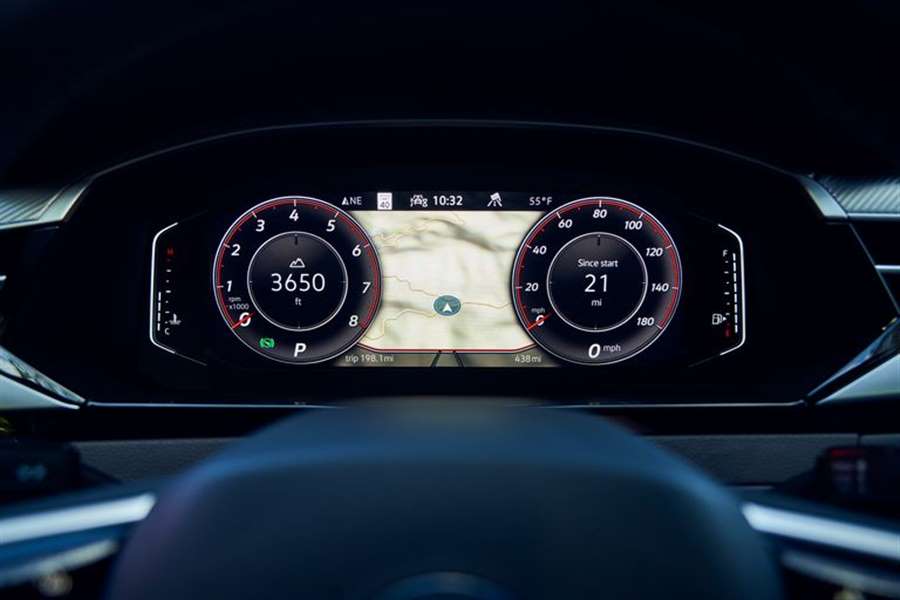
HIGHS: Simply stunning styling, Audi-esque interior environment, crossover-like cargo space.
The raft of subtle, albeit meaningful, changes don't affect the Arteon's cargo or passenger space. The pilot's seat remains more relaxing than engaging, with front-seat cushions that err on the side of supple rather than supportive. Too bad the "massaging" driver's seat felt like sitting in front of a disgruntled toddler on an airplane. At least adults in the back still enjoy legroom worthy of a luxury car and a surprising amount of headroom despite the hatchback's diving rear roofline. The Arteon is almost as practical as a compact crossover, too, with an expansive cargo area that'll hold nine carry-on suitcases behind the back seat. Fold them down and luggage capacity tops out at 21 carry-ons—only three fewer than we fit in a VW Tiguan.
A Fine Luxury Car—for the Right Price
Those satisfied with the Arteon's one-size-fits-all powertrain—a 268-hp turbo 2.0-liter four-pot paired with an eight-speed automatic—won't care that it's unchanged. Those hoping we'd get the 315-hp version from the European Arteon R are out of luck. However, the EPA highway fuel-economy figure has swelled by 4 mpg to 31 since 2019, a figure we matched during our real-world highway test at 75 mph. Every top-trim SEL Premium has standard 4Motion all-wheel drive, which helped our test car reach 60 mph in 6.4 seconds. While neither that time nor the 4.6-second sprint from 50 to 70 mph qualifies as lazy, the Arteon isn't exactly exciting when goaded with wide-open throttle. The interior is nicely insulated from wind and road noise, but a heavy right foot reveals engine sounds that aren't racy. The automatic has polite manners and deliberate responses, but its tendency to upshift early favors fuel economy over playfulness, making the steering-wheel-mounted paddle shifters necessary.
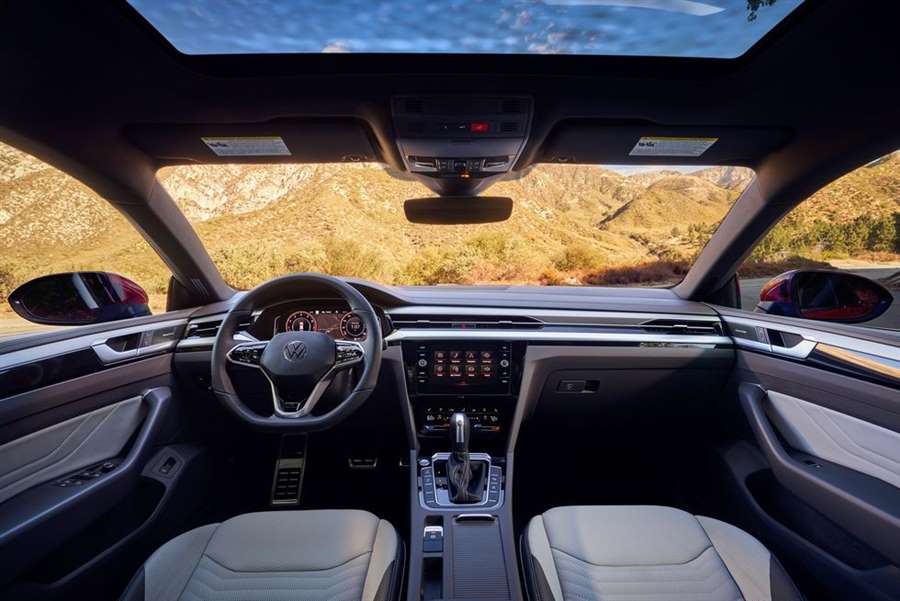
LOWS: Unexhilarating engine sounds, massaging driver's seat feels like being kicked by a toddler, barely cheaper than an Audi alternative.
During our time with the Arteon, we discovered that it's best enjoyed at a relaxed pace. Sure, the hatchback can be hurried if you insist, but it's a luxury car first. Its light steering is accurate and body control is poised, but the Arteon is mostly indifferent to corners. The hatch's surprisingly rigid structure and graceful ride quality remind us that VW is really good at building cars that feel expensive. Which is fortunate, because this one actually is.
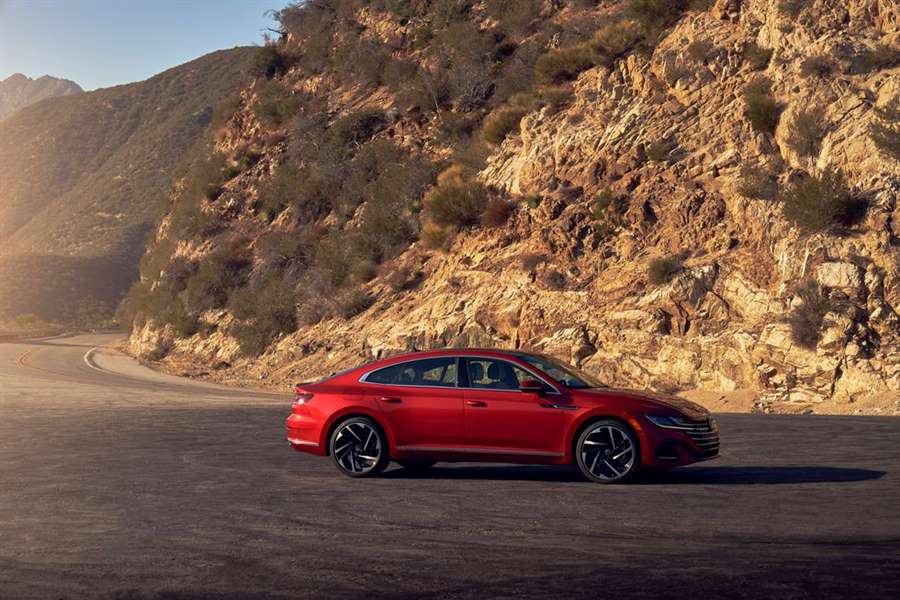
Although the Arteon is certainly a special Volkswagen and a fine mid-size luxury car, it's not really an affordable Audi alternative because, well, it's not much more affordable. Our SEL Premium R-Line had an as-tested price of $48,190, which is only $1755 shy of a loaded A5 Sportback. In a way, the Arteon is the last throwback to the Piëch-era VWs, the Phaetons and Touaregs, that sought to transcend their badges. And that it does, rewarding the select few who are paying attention.
Source: caranddriver.co.uk

